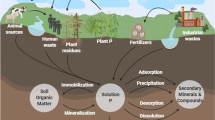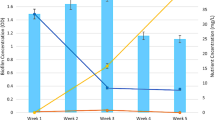Abstract
The properties of three amidohydrolases, i.e., urease (I) EC 3.5.1.5, L-asparaginase (II) EC 3.5.1.1, and L-glutaminase (III) EC 3.5.1.2, were studied in sediment samples taken from a shallow eutrophic freshwater lake.
Sediment samples were air dried (ADS) and stored for at least 3 months before being enzymically characterized. The pH optimum of I, II, and III were pH 7.0, 8.4, and 6.5–7.0, respectively, while III in soluble extracts from ADS was most active between pH 8.0 and 9.0. The temperature response of the three enzymes in ADS gave Ea values of 38.9, 41.6, and 35.9 kJmol−1 for I, II, and III, respectively. Km and Vmax values for ADS I, II, and III were 1.2 mM and 1.9μmol NH3 g−1h−1; 0.8 mM and 4.1μmol NH3 g−1h−1; and 1.25 mM and 17.4μmol NH3 g−1h−1. Km values for all three enzymes in ADS extracts were at least an order of magnitude greater than those of the ADS. The susceptability of each enzyme to proteolysis was followed in ADS and fresh wet sediment and compared with that of III in an ADS extract. All sediment enzymes were found to be more resistant than the commercial preparation of bacterial L-glutaminase subjected to the same treatment. These results suggested that I, II, and III all exist to some extent as colloid-immobilized enzyme fractions in freshwater sediments and are analogous to the stable enzyme fractions in soils.
Similar content being viewed by others
References
Billen G (1982) Modelling the processes of organic matter degradation and nutrients recycling in sedimentary systems. In: Nedwell DB, Brown CM (eds) Sediment microbiology. Academic Press, London, pp 15–52
Bremner JM, Mulvaney RL (1978) Urease activity in soils. In: Burns RG (ed) Soil enzymes. Academic Press, London, pp 149–196
Bullock P, Loveland PJ (1974) Mineralogical analyses. In: Avery BW, Bascomb CL (eds) Soil survey laboratory methods. Harpenden Press, Rothamsted, pp 57–69
Burns RG (1978) Enzyme activity in soil: Some theoretical and practical considerations. In: Burns RG (ed) Soil enzymes. Academic Press, London, pp 295–340
Burns RG (1982) Enzyme activity in soil: Location and a possible role in microbial ecology. Soil Biol Biochem 14:423–427
Chandramohan D, Devandran K, Natarajan R (1974) Arylsulphatase activity in marine sediments. Mar Biol 27:89–92
Dalal RC (1975) Effect of toluene on the energy barriers of urease activity of soils. Soil Sci 120:256–260
Dharmaraj K, Selvakumar N, Chandramohan D, Natarajan R (1977) L-Glutaminase activity in marine sediments. Indian J Mar Sci 6:168–170
Duddridge JE, Wainwright M (1982) Enzyme activity and kinetics in substrate-amended river sediments. Water Res 16:329–334
Frankenberger WT, Johanson JB (1983) Amidohydrolase activities in natural waters. Pol Arch Hydrobiol 30:319–329
Frankenberger WT, Page AL (1983) The effects of acidity and alkalinity on the stability of amidohydrolases in freshwater. J Envir Qual 12:459–462
Galstyan ASh, Saakyan EG (1973) Determination of soil L-glutaminase activity. Dolk Akad Nauk SSSR 209:1201–1202
Gould WD, Cook FD, Webster GR (1973) Factors affecting urea hydrolysis in several Alberta soils. Pl Soil 38:393–401
Jones JG (1979) Microbial nitrate reduction in aquatic sediments. J Gen Microbiol 115:27–35
Jones JG (1982) Activities of aerobic and anaerobic bacteria in lake sediments and their effect on the water column. In: Nedwell DB, Brown CM (eds) Sediment microbiology. Academic Press, London, pp 107–145
Kiss S, Dragan-Bularda M, Radulescu D (1975) Biological significance of enzymes accumulated in soils. Adv Agron 27:25–87
Lea PJ, Fowden L, Miflin BJ (1978) Purification and properties of Asparaginase fromLupinus sp. Phytochem 17:217–222
Levin Y, Pecht M, Goldstein L, Katchalski E (1964) A water-insoluble polyanionic derivative of trypsin. I. Preparation and properties. Biochem 3:1905–1913
McLaren AD, Babcock KL (1959) Some characteristics of enzyme reactions at surfaces. In: Hayashi T (ed) Subcellular particles. Ronald Press, New York, pp 23–35
Meyer-Reil LA (1981) Enzymatic decomposition of proteins and carbohydrates in marine sediments: Methodology and field observations during sampling. Kieler Meeresforsch Sonderh 5:311–317
Mortimer CH (1941) The exchange of dissolved substances between mud and water in lakes (Parts I and II). J Ecol 29:280–329
Mouraret M (1965) L-Asparaginase activity in soil. Memoires, Orstom, Paris
Omura H, Sato F, Hayano K (1983) A method for estimating L-glutaminase activity in soils. Soil Sci Pl Nutr (Tokyo) 29:295–303
Paulson KN, Kurtz LT (1970) Michaelis constant of soil urease. Soil Sci Soc Am J 34:70–72
Perucci P, Guisquiani PL, Scarponi L (1982) Nitrogen losses from added urea and urease activity of a clay-loam soil amended with crop residues. Pl Soil 69:457–463
Pettit NM, Smith ARJ, Freedman RB, Burns RG (1976) Soil urease: Activity, stability and kinetic properties. Soil Biol Biochem 8:479–484
Pulford ID, Tabatabai MA (1988) Effect of waterlogging on enzyme activities in soils. Soil Biol Biochem 20:215–219
Radulescu D, Kiss S (1971) Enzyme activities in the sediments of the Zanoaga and Zanoguta lakes (Retezat mountain mass). In: Progress in Roumanian palinology. Ed Acad Rep Soc Rom, Bucharest, pp 243–248
Satoh Y (1981) Decomposition of urea by a size-fractionated planktonic community in a eutrophic reservoir in Japan. Hydrobiologia 83:153–160
Selvakumar N, Chandramohan D, Natarajan R (1977) L-Asparaginase activity in marine sediments. Curr Sci 46:287–291
Sepers BJ (1981) Diversity of ammonifying bacteria. Hydrobiologia 83:343–350
Skiba U, Wainwright M (1983) Assay and properties of some sulphur enzymes in coastal sands. Pl Soil 70:125–132
Tabatabai MA (1973) Michaelis constant of urease in soils and soil fractions. Soil Sci Soc Am Proc 37:707–710
Wade HE (1980) Synthesis and functions of microbial asparaginases and glutaminases. In: Payne JW (ed) Microorganisms and nitrogen sources: Transport and utilization of amino acids, peptides, proteins and related substances. Wiley Interscience, Chichester, pp 563–575
Zantua MI, Bremner JM (1975) Comparison of methods of assaying urease activity in soils. Soil Biol Biochem 7:291–295
Zantua MI, Bremner JM (1977) Stability of urease in soils. Soil Biol Biochem 9:135–140
Zeikus JG (1983) Metabolic communication between biodegradative populations in nature. In: Slater JH, Wittenbury R, Wimpenny JW (eds) Microbes in their natural environments. Cambridge University Press, Cambridge, pp 423–462
Author information
Authors and Affiliations
Rights and permissions
About this article
Cite this article
Sallis, P.J., Burns, R.G. The characterization of amidohydrolases in a freshwater lake sediment. Microb Ecol 17, 159–170 (1989). https://doi.org/10.1007/BF02011850
Issue Date:
DOI: https://doi.org/10.1007/BF02011850




